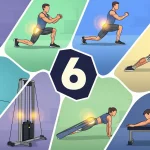Fit People, honestly, do you still think stretching is just a warm-up formality?
Think about this, if you can go all out for an hour of weight training but skip 10 minutes of stretching, you’re neglecting the part of your body that needs the most attention at that moment tired and tight muscles.
In fact, stretching isn’t just about flexibility. It’s about blood circulation, the nervous system, and even your posture and mood.
What Is Stretching and Why Is It Important?
Stretching is the process of lengthening muscles and body tissues through specific movements to increase flexibility, improve posture, and maximize range of motion.
If your muscles are stiff, blood circulation will be hindered. If this continues, you’ll be more prone to injury even during simple movements, like going down stairs or suddenly squatting.
Furthermore, stretching also activates the parasympathetic nervous system (the body’s “rest and digest” system), which helps you feel relaxed and focused.
In short, stretching isn’t just a warm-up. It’s an important part of performance and recovery.
6 Types of Stretching You Need to Know
1. Static Stretching – The Misunderstood Cool Down
- Definition: Passive stretching by holding a position for 10–60 seconds.
- When: After your workout, when muscles are already warm.
- Examples: Seated toe touches, standing quad stretch.
Benefits:
- Helps muscles relax after activity
- Reduces delayed onset muscle soreness (DOMS)
- Guides your body into recovery mode
Note: Doing static stretches before heavy workouts can reduce muscle strength by up to 8% (Harvard Health).
2. Dynamic Stretching – Your Real Warm-Up
- Definition: Repetitive, active movements that mimic your actual workout.
- Examples: Leg swings, arm circles, walking lunges.
Benefits:
- Raises your body temperature
- Activates neuromuscular pathways
- Mentally and physically preps your body
If you skip dynamic stretching before the gym, it’s like stepping into a boxing ring without warming up—ready to get hit by the first punch.
3. Ballistic Stretching – Bouncy, Fast, and Risky
- Definition: Stretching with bouncing movements beyond your normal range.
- Example: Bouncing toe touches.
Benefits:
- Aggressively increases flexibility
- Used by elite athletes (sprinters, martial artists)
Without professional supervision, this type of stretching can do more harm than good.
4. PNF Stretching – The Physio’s Favorite
- Definition: Proprioceptive Neuromuscular Facilitation involves contraction-relaxation cycles with a partner.
- Example: Partner-assisted hamstring stretch with resistance.
Benefits:
- Deeply improves muscle flexibility
- Great for injury rehab
- Ideal for dancers, yogis, and gymnasts aiming for extreme range of motion
5. Active Stretching – You vs. Your Own Muscles
- Definition: Stretching using your own muscle strength, no external help.
- Examples: Warrior II, Boat Pose, Pigeon Pose in yoga.
Benefits:
- Builds body awareness
- Strengthens stabilizer muscles
- Improves posture, balance, and focus
6. Passive Stretching – Chill but Powerful
- Definition: Stretching with help from equipment or a partner to maintain position.
- Examples: Using a strap or partner for deeper stretches.
Benefits:
- Excellent for relaxation and recovery
- Helps post-injury recovery
- Restores muscle elasticity
When to Do Which Type of Stretching?
| Type of Stretching | When to Do It | Purpose |
| Dynamic | Before exercise | Muscle activation & mobility |
| Static | After exercise | Cool-down & recovery |
| PNF | Specific sessions/rehab | Extreme flexibility |
| Ballistic | Only for pro athletes | Intensive training |
| Passive | During cool-down/relaxation | Muscle regeneration |
| Active | Anytime (even daily) | Posture & body control |
Safe and Effective Stretching Tips
- Don’t chase pain. It should feel like a pull, but not painful.
- Breathe, don’t hold your breath. Rhythmic breathing helps the body relax.
- Cold muscles = no static stretching. This can tear muscle fibers.
- Do it consistently, not just when you remember.
Conclusion: Stretching Is a Ritual, Not a Formality
If you’ve been stretching haphazardly or just following along, it’s time to realize: Stretching is a science that needs to be understood.
The good news is you don’t have to learn by yourself. At Grand Focus Fit, you can join Stretching & Recovery sessions with instructors who understand your body’s needs.
Not only will they make you more flexible, but they’ll also help you #StayFocus and push past limits you thought were impossible.
So, are you still going to skip stretching tomorrow?





